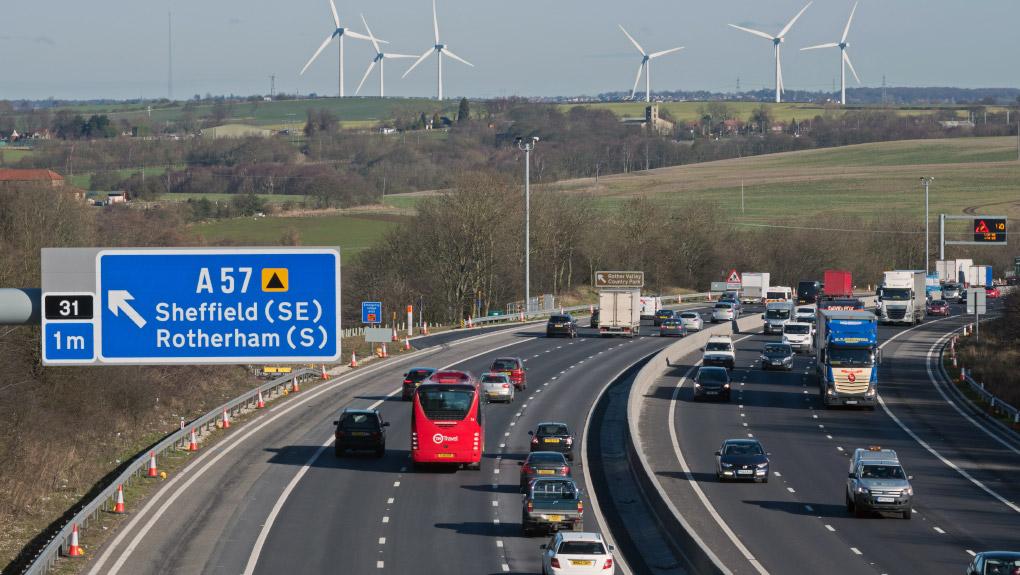
User satisfaction and average traffic delays across six regions of England varied significantly, but performance was more aligned in supporting the smooth flow of traffic and the condition of the road network, where each region improved.
Evidence of regional differences is provided in ORR’s Benchmarking Highways England: 2020 Progress Report, which examined Highways England’s performance across: Yorkshire and the North East, North West, Midlands, East, South East and South West of England regions against key metrics including user satisfaction, network availability, incident clearance, average traffic delay and road condition.
The report shows:
- User satisfaction varies significantly across Highways England’s regions and scores can fluctuate from year to year. National user satisfaction was 89% in 2019-20, slightly below the 90% target. Regional levels ranged from 93% in Yorkshire and the North East to 85% in the North West.
- Average traffic delay: Nationally average traffic delay in 2019-20 was nine seconds per vehicle mile. There was a difference in average delays of three seconds per mile (38%) between the region with the highest level of delays (South East) and the region with the lowest level of delays (South West).
- Road condition: Highways England aims to keep 95% of its road surface in a good condition. The condition of the road network improved in every region, ranging from Yorkshire and the North East ensuring 97% of the network did not require further investigation to the Midlands and the East of England, which achieved 94%.
- Network availability: Each region ensured that at least 98% of the network was open and available for traffic, with all regions performing at a similar level (98%) with the South West achieving a score of 99%.
- Clearing incidents: All regions significantly improved performance in the way that they deal with traffic incidents. Nationally, Highways England increased the proportion of incidents cleared to 89% in 2019-20. Regional performance ranged from 88% in the East to 90% in the Midlands.
- Maintenance and renewal spending: Nationally, there was a gradual reduction in maintenance spending during the first road period (2015-2020). The Midlands region had the highest average spending per lane mile – 17% more than the South West. By its nature renewals spending fluctuated to a greater extent than maintenance but regional variation reduced significantly by the end of the period.
- International comparisons: In the 2020 progress report, ORR benchmarked fatality rates on motorways across a selection of European countries. This shows that the rate of fatalities (deaths per vehicle mile) is low in England compared to other European countries. It also shows similarities in longer term trends in motorway fatalities. Most countries saw large reductions in fatalities during the 2000’s. However, in the last 10 years the number of fatalities on motorways has levelled off.
Variation across regions may be explained by differences in network characteristics, particular circumstances faced by a region, or differences in approach or performance.
ORR will be requiring Highways England to provide better cost and spending data at regional level in respect of operations, maintenance, and renewals to provide greater transparency and help to better understand whether differences over time and between regions reflect more efficient delivery.
Graham Richards, Director of Planning and Performance at the Office of Rail and Road, said:
Notes to editors Collapse accordion Open accordion
- ORR is responsible for monitoring and enforcing the performance and efficiency of Highways England. We hold Highways England to account for its management of the strategic road network. ORR also advises the UK Government on the levels of funding and performance requirements for future road periods to help frame challenging and deliverable performance and efficiency requirements.
- ORR does not regulate the safety of the Strategic Road Network in the same way as we do for the railways. However, we monitor performance indicators related to safety that form part of Highways England’s overall performance monitoring framework.
- The Benchmarking Highways England: 2020 Progress Report benchmarks accomplishment against five key performance indicators across three of the outcome areas in Highways England’s performance specification: Improving User Satisfaction, Supporting the Smooth Flow of Traffic, and Encouraging Economic growth.
- This year’s report summarises performance over the whole of the first road period (2015-16 to 2019-20).
- Highways England national targets for Road Period 1 were: A score of 90% user satisfaction, 97% lane availability, at least 85% of incidents cleared within one hour, minimal average delays and 95% of pavement condition requiring no further investigation for possible maintenance.
- Alongside our regional benchmarking, we have undertaken a range of targeted investigations during the first road period including on operating efficiency, traffic conditions, roadworks management and incident management.
- Road condition is an issue which Highway England has identified within its business plan for road period 2 (2020-21 to 2024-25) and it will be undertaking a specific programme of concrete renewals over the next five years. ORR continues to scrutinise Highways England’s work in this area and is working with the company to improve how it reports maintenance activities like fixing potholes, clearing litter, and inspecting its network.
- In this report, ORR also compares how Highways England is delivering against international comparators in respect of the safety of motorways. This shows striking similarities in trends over the last 20 years with most countries achieving significant reductions in fatalities in the first decade but a flattening out of performance in the last 10 years.

